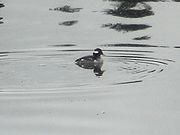Bucephala albeola
From marinelife1011
Bucephala albeola is commonly known as the Bufflehead. It is the smallest diving duck in North America.[1] The name bufflehead or "buffalo head" refers to its bulbous head shape. This is most noticeable when a male puffs out his head feathers, increasing the size of its head.[2]
| Bufflehead | |
|---|---|
 |
|
| Female Bufflehead taken by M. Blevins Jan. 2011 Olympia, WA | |
| Scientific classification | |
| Kingdom: | Animalia |
| Phylum: | Chordata |
| Class: | Aves |
| Order: | Anseriformes |
| Family: | Anatidae |
| Genus: | Bucephala |
| Species: | albeola |
| Binomial name | |
| Bucephala albeola Linnaeus, 1758 |
|
Contents |
Description
Physical Description
The Bufflehead can grow between 12.5 - 16 inches (32-40 cm) and weigh 0.6-1.2 lbs (270-550 g). The species is Dimorphic, which means the males, also called Drakes, are larger than females. Drakes have a glossy, greenish-black head with a large white cap behind the eyes. Their body is mainly white with a black back. Females have a brown head with a smaller white patch behind the eyes. Their body color is mainly brown with a light underside.[2]
Diet and Feeding
Bufflehead like to forage underwater. They feed by diving to the cove bottom where they consume benthic invertebrates including crustaceans, gastropods, and bivalves.[3] Sometimes they feed on fish eggs and aquatic plants.[2] Like other diving ducks, the Bufflehead can swallow while underwater.[4]
Reproduction and Life History
Reproduction
Bufflehead courtship, by males, is extremely animated. It involves chasing, head pumping and erecting a bushy crest to enlarge their head. Males chase other males away, but also chase after females. Females respond with vocalizations and a less animated head display telling her suitor to continue his courtship.[5] Like most other seaducks, Bufflehead experience long term pair bonds.[6] Breeding occurs in Alaska or Canada.[2] Females prefer to nest in the cavities of trees. They are reluctant to leave the nest and usually do so in the evening. It’s not uncommon for a female to use the same nesting site more than once, if not driven out by predators. Mothers stay with ducklings until 7-8 weeks of age and if abandoned, it’s not uncommon for ducklings to be adopted by another brood.[5]
Life History
In a study of tagged Buffleheads, the oldest recorded male was 15 yrs old, oldest female was 12 yrs old.[4]
Habitat
Habitat
During the winter, Buffleheads spend the majority of their time on the water and tend to favor shallow water habitats.[3] They winter in coastal waters on the east and west coasts of North America. They do not collect in huge flocks, usually less than 10.[2] Bufflehead have a strong tendency to return to the same wintering area.[6]
Conservation
Conservation
Bufflehead ducks are hunted for sport in US and Canada. Their breed makes up 2% of duck sport hunting. Ducks return to breeding ground year after year. With with local over harvesting devastates the population while clear-cut lumbering threatens forest habitat.[4]
References
- ↑ “All About Birds” Cornell Lab of Ornithology. Copyright 2010. Retrieved 1/31/2011. http://www.allaboutbirds.org/guide/Bufflehead/lifehistory
- ↑ 2.0 2.1 2.2 2.3 2.4 “Bufflehead Ducks” AvianWeb.com. Copyright 2010. Retrieved 1/31/2011. http://www.avianweb.com/buffleheadduck.html
- ↑ 3.0 3.1 McKinney, Richard A., McWilliams, Scott R. "A New Model to Estimate Daily Energy Expenditure for Wintering Waterfowl". The Wilson Bulletin, Vol. 117, No. 1 (2005) p.44-55.
- ↑ 4.0 4.1 4.2 Roof, Jennifer. “Bucephala albeola”, Animal Diversity Web. Copyright 2008. Retrieved 1/31/2011 http://animaldiversity.ummz.umich.edu/site/accounts/information/Bucephala_albeola.html
- ↑ 5.0 5.1 Dye, Paul, “Bufflehead Ducks – Mighty Mights”. [Internet] Retrieve 1/31/2011. http://www.greatnorthern.net/~dye/Bufflehead_ducks.htm
- ↑ 6.0 6.1 Gauthier, Gilles. "Further Evidence of Long-term Pair Bonds in Ducks of the Genus Bucephala", The Auk, Vol. 104, No. 3 (July 1987), p. 521-522.
Links
Video: Mating Behavior: http://www.youtube.com/watch?v=HDb2tvhhqu8
Video: Underwater swimming http://www.youtube.com/watch?v=rGtQL5uqd8I
